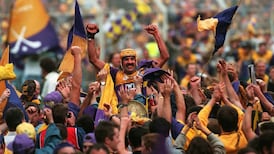Since the GAA doesn’t keep a comprehensive databank of results (boo, hiss), whatever bits of flotsam the internet throws up in terms of records can always stand to take a bit of double checking.
So it was with an arched eyebrow that could have taken down a low-flying aircraft that we came across the scoring totals from the 2003 Allianz Hurling League during the week.
At first glance, they carried all the credibility of a TD spoofing away about why we still have no government. But when we drilled down a bit deeper, they turned out to be correct. That year’s league structure was a bit of a wheeze even by the standards of the genre – two divisions of five teams, then after five games the top three from each division played each other in a new league with the scoring difference carrying over. Essentially, everybody played eight games and when it was all over Kilkenny beat Tipperary in the final.
Nothing extraordinary in that, obviously. What’s mind-boggling is the level of goalscoring across the league that year. In 48 regular league games, the teams put up 181 green flags – an average of 3.73 a game. If you add in the final – a frankly hilarious ding-dong in Croke Park that ended 5-14 to 5-13 – the average tips up to 3.89.
Everybody got in on the act that spring. Dublin took a few right tonkings but still managed 18 goals in their eight games.
Tipp and Cork both scored 19, Waterford 17, Kilkenny 15. Even Derry, who didn't win a game and ended up relegated with a points difference of -141, went through the trapdoor with 10 goals to their name.
If it’s not clear to anyone what was in the water on those heady early months of 2003, it’s pretty obvious watching this year’s league that the well has long run dry.
Couple of decades
In the regulation rounds in Division 1A, there were only 29 goals in 15 games. That’s an average of 1.93 goals per games, the first time we could find digging back a couple of decades (again – boo, hiss, GAA) that it has dipped below two.
The average rose with the first round of knockout games, mostly by dint of Kilkenny walking six past Offaly a fortnight ago. Add in the five goals from the other three quarter-finals and Cork’s two against Galway in the relegation play-off and so far in the 2016 hurling league, the games involving Division 1A teams have coughed up an average of just 2.1 goals each.
Goal averages can be a blunt enough tool, of course. Division 1A in 2016 isn’t the same as Division 1A in 2003, for a start. These days, Division 1A is the top of the shop. Cork had a desperate league but even they only got one real scorching, the 4-21 to 2-17 punishment beating from Dublin in Croke Park last month.
Back in 2003, Cork were able to feast on Derry to the tune of 6-19 to 1-5 and Tipp could run up a 4-14 to 1-8 pummelling against Offaly. Division 1A and 1B were two sides of the same coin, a mixum-gatherum of the top and the not-so-top teams, with the occasional gulf in class built into the system. In that scenario, there will be goals.
Even so, the past five seasons provide a big enough sample size to clock some trends of what happens when the top teams meet on a regular basis. In 75 regulation games since the league was restructured for the 2012 season, there have been 190 goals. That’s an average of 2.53 per game. It bobs and weaves from year to year, naturally enough. But for it to go down to 1.93 is a definite shift.
You can get caught in a hailstorm of decimal points with all this stuff but nobody who’s been to a couple or more league games this spring will be surprised by the averages. Simply put, most of the teams in the top division have not been set up with goalscoring in mind.
Waterford are the obvious starting point. They arrive at tomorrow's semi-final against Limerick having scored one goal in seven games. In the past decade, only two teams have gone through a league with just one goal to their name and both of them – Waterford themselves in 2014 and Dublin in 2005 – were relegated.
In fact, Derek McGrath’s side have only scored five points more this time around to finish second than they did two years ago to finish last – 1-90 as opposed to 1-85.
The difference is blindingly clear when you look at how they’re set up.
Waterford’s last three Division 1A games in 2014 coughed up 5-18 to Clare, 4-22 to Kilkenny and 4-13 to Dublin – 13 goals in three games. Since McGrath reconfigured his side for the start of the 2015 league, they’ve conceded 12 in 18. Waterford protect their queen, their castle and anything else that needs saving. Tigran Petrosian with Deise accents.
Bad press
And they're far from alone. Waterford get all the bad press but that average didn't come down by itself or by accident. Kilkenny only scored four goals before Offaly waved them through for that half-dozen, Dublin could muster only five. It would only take heat-mapping the likes of Colin Fennelly or David Treacy for a game or two to explain why.
The vogue across the league is for half forwards dropping back into their half-back line and teams playing a lot of the time with just one forward inside. The gradual footballisation of hurling has been coming for a few seasons and turned last summer in particular into a grind of ultra-professional, superbly coached players taking the right – the safe – option. There is very little evidence to suggest that the summer to come will be any different.

















